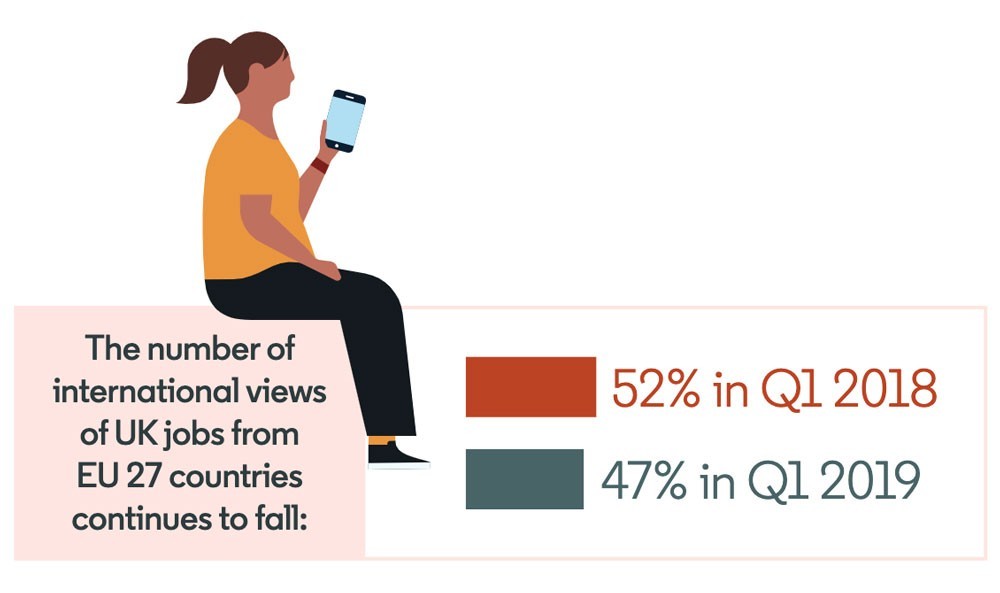How British Companies Can Tackle the Talent Challenges Created by Brexit and a Tight Labor Market
When the United Kingdom voted to leave the European Union three years ago, no one knew what Brexit would look like, only that it was likely to be messy. We now know it will also be protracted — the March deadline for finishing terms of the exit has been extended to the end of October.
Call it The Long Goodbye.
And while we still can’t be sure exactly how Brexit will play out, we do know that U.K. businesses are already feeling its effects. Data and research captured in the LinkedIn Workforce Insights report reveals that Brexit has hurt the ability of British companies to attract workers from the EU27 — the 27 European member states who will remain in the union. And this increasing difficulty in attracting talent from abroad comes as U.K. unemployment hovers at 3.8%, the lowest point since the winter of 1974–75.
LinkedIn data shows that the number of job seekers from EU27 countries viewing open positions in the United Kingdom started dropping after the June 2016 referendum vote and continues to decline. The number, as a share of all international views of job openings in the U.K., dropped from 52% in the first quarter of 2018 to 47% in the first quarter of 2019.
LinkedIn’s Recruiter Sentiment survey of 600 in-house HR professionals and agency recruiters across the United Kingdom reinforced that finding: Some 43% of respondents told us the U.K. is less attractive to E.U. candidates, and 61% of recruiters today say they are “extremely confident” or “very confident” they can recruit the right candidates, down from 71% a year ago.
Here are three tactics companies in the U.K. should consider — and in some cases already have — to counter the declining access to a key source of international talent and a tight labour market:
1. Bolster your retention efforts
While companies will still need to bring in talent as their businesses evolve and grow, reducing attrition will also keep the stress on your recruiting team from going haywire. So while more than half (54%) of the talent professionals we polled said their companies have increased salary offers to land the right people, U.K. businesses are also shoring up their retention efforts. Importantly, 43% said their companies are giving bumps to key people to prevent them from leaving.
Many U.K. firms have also rethought their benefit offerings. Nearly half (49%) of our respondents told us businesses have boosted benefit offerings such as pension contributions to attract and retain talent.
Another benefits trend LinkedIn uncovered is U.K. companies embracing flexible work opportunities. Our survey found 41% of companies are creating more flexible options, which can range from an unrestricted anytime, anywhere policy to unconventional hours or simply minimized travel. In addition to attracting talent and improving retention, work flexibility can increase productivity, diversity, and employer brand as well as cut costs.
2. Upskill your current workforce to stay ahead of looming skills gaps
Upskilling your existing employees is a great retention tool. But beyond that, learning and development programs are a proven tactic for plugging the skills gaps that your company may face in a tight labor market.
To build a successful L&D program, know what your company’s needs are — and will be. Find experts in your own organization to act as teachers, make it easy for them to create content, and then promote the heck out of your program. Short of internal experts? Check out the courses at LinkedIn Learning — they range from Python and C++ to communication and collaboration.
3. Tap into underleveraged talent pools
According to the Recruiter Sentiment survey, 75% of U.K. respondents report an increase in businesses shifting their sourcing from international candidates to ones in the United Kingdom. Three pools in which recruiters are diving deeper than ever are women, particularly mothers who have stepped out of the workforce; older workers; and students.
“The growth in employment was driven mainly by the number of women getting into jobs,” said the U.K.’s Office for National Statistics, explaining the most recent trend in hiring. The employment rate for women working in Britain (71.8%) equaled an all-time high.
Female unemployment in the United Kingdom has never been lower, so companies looking to bring on more women will need the right tactics. One simple tip for recruiters: Open more profiles of female candidates. LinkedIn research shows that recruiters are 13% less likely to click on a woman’s profile when she shows up in search. But when recruiters do look at a woman’s profile, they are just about as likely to reach out as when they open a man’s.
In particular, women who have stepped out of the workforce — to have children, take care of elderly parents, or deal with personal medical issues — and are now looking to return can be an underleveraged pool of talent, especially for companies willing to provide training and development.
––––––––––––––––––––––––––––––––––––––––––––––––––––––––––––––––
Related: 8 Tips to Improve the Gender Diversity of Your Recruiting Pipeline
––––––––––––––––––––––––––––––––––––––––––––––––––––––––––––––––
ONS statistics also point to companies hiring more workers in the 50-to-64 age bracket. If you’re looking to hire more seasoned professionals, consider scrubbing your job descriptions of words such as youthful, energetic, dynamic, and digital native that might unintentionally signal to older workers that you’re not interested in them. You may also want to embrace skills tests and auditions as part of your hiring process to reduce unconscious bias. And think about tweaking your benefit mix, which may be designed to tantalize younger workers with perks like fertility help, parental leave, or onsite child care. Instead, weigh flexible work options, savings plan contributions, or — as many U.K. companies seem to be moving toward — a boost in pension contributions.
The ONS data also shows that more and more students in the U.K. are joining the workforce. Some 45% of talent professionals told LinkedIn they are seeing an increase in the number of corporate programs for graduates and 40% said they’ve seen a hike in internship programs across the UK. These new programs are right on target: In a LinkedIn survey of 2,000 Gen Zers last year, 93% said that learning opportunities are a valuable tool for recruiting Gen Z.
Final thoughts: Give your employer brand some TLC — and reap the benefits
The good news about the tactics outlined above is that they will all lead to your company having an even stronger employer brand. Increasing compensation, offering more work flexibility, and rolling out a robust learning and development program will go a long way toward creating an enviable employer brand.
But don’t stop there. Figure out which career site metrics are most important to your company and build a content strategy to lift those measures. “It’s about effort,” says employer brand expert Ed Nathanson. “It’s about dedication. It’s about doing your homework and about being authentic and understanding the importance of humor and heart.” Among Ed’s top tips for upping your employer-brand game are improving your candidate experience (by, among other things, sending thank-you notes to candidates), pitching your company’s culture and experts (rather than just products and services), and drafting your front-line employees to be your top brand ambassadors.
While British firms may struggle in the short term to recruit from EU27 countries, a strong employer brand may be the best tool they can develop to ensure they have access to the talent pools they need in the United Kingdom — and beyond.
To receive blog posts like this one straight in your inbox, subscribe to the blog newsletter.
*Photo by King's Church International on Unsplash
Topics: Data insights
Related articles





